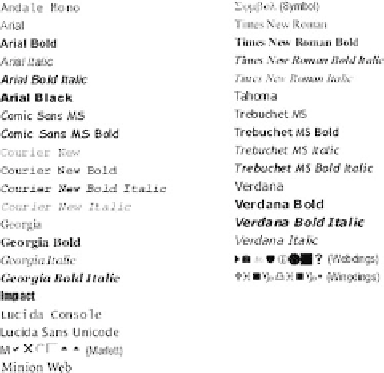HTML and CSS Reference
In-Depth Information
fonts using
font-family
and
font
properties. For example, to set the font more or less as
we did in previous HTML examples, you would use a rule like the following:
<p>
This is standard text.
<span style="font-family: Britannic Bold;">
This is
text in Britannic Bold?
</span>
More standard text.
</p>
Of course, the same restriction of fonts available on the local system applies, so a
comma-delimited list of fonts should be specified like so:
<p>
This is standard text.
<span style="font-family: Arial, Helvetica, sans-
serif;">
This should be in one of the Sans Serif fonts listed or default to
the standard sans-serif font installed
</span>
This is more standard text.
</
p>
Clearly these examples are more illustrative than appropriate, as we should use external
style sheets and the like. Our main aim in this appendix is to show that regardless of the
approach taken to effectively use fonts in this manner, we must provide an equivalent list of
fonts, or at least roughly so, across Macintosh, Windows, and Linux systems if we aim to
provide a similar text rendering. The following sections present the fonts of these various
systems so that we can determine what fonts may be used; later we'll review ways to
specify fonts that are downloaded to remove this search for cross-platform similarity.
Fonts for Windows Platform and Browsers
Table B-1 lists the fonts that are available for Microsoft browsers and systems; they are
displayed in Figures B-1 and B-2.
F
IGURE
B-1
Font families
available for
Microsoft browsers
and systems


